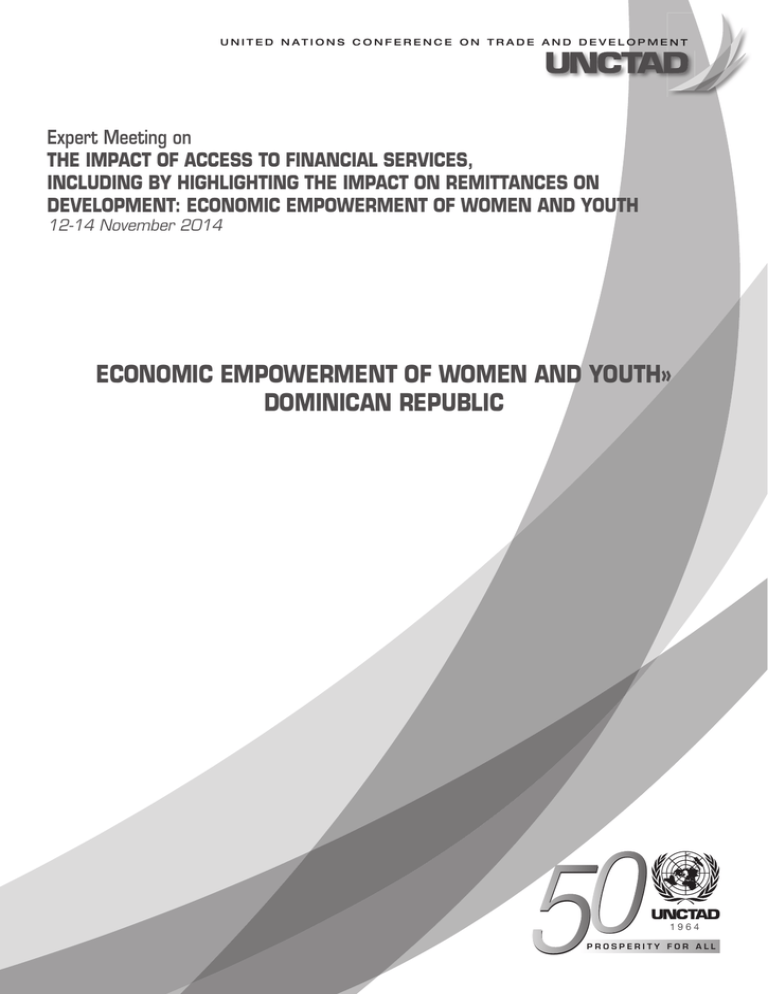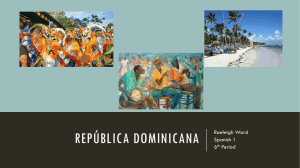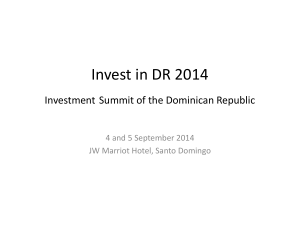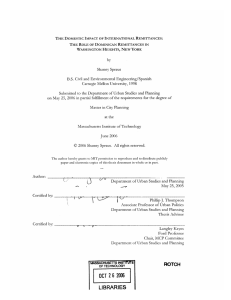Document 10705924
advertisement

U N I T E D N AT I O N S C O N F E R E N C E O N T R A D E A N D D E V E L O P M E N T Expert Meeting on THE IMPACT OF ACCESS TO FINANCIAL SERVICES, INCLUDING BY HIGHLIGHTING THE IMPACT ON REMITTANCES ON DEVELOPMENT: ECONOMIC EMPOWERMENT OF WOMEN AND YOUTH 12-14 November 2014 ECONOMIC EMPOWERMENT OF WOMEN AND YOUTH» DOMINICAN REPUBLIC 0 5 1964 PROSPERITY FOR ALL Single-year Expert Meeting on the Impact of Access to Financial Services, Including by Highlighting Remittances on Development: Economic Empowerment of Women and Youth" Geneva from 12-14 November 2014. Dominican Republic Like most developing countries, the Dominican Republic is making efforts to increase access to financial products and services to its population, undertaking joint actions between the public and private sectors that seek to provide them at a reasonable cost to unbanked segment populations. Particularly the uses of bank subagents, mobile payments and prepaid cards of government grants respond to this combination of policies. In the case of the subagent , this tool in spite of having a significant time on the layout , has not reached expected levels , to that effect, and considering that this is a very slow process because of the low levels of financial education of the population, public and private sectors altogether, with the goal of establishing an equilibrium between maximizing banking rentability and welfare of society and assuming a position of social responsibility of lower profitability in the short term but a higher one in the long term, has initiated an advertising campaign with the development of financial education programs aimed at the entire nation. However, note that the use of technology has significantly boosted financial services, providing secure, agile and efficient tools to carry out payment mechanisms for goods and services as well as access to the various financial products available. The joint efforts made are supported by The general legal framework of the Dominican Republic that are constituted by: Monetary and Financial Law 183-02 (2002 ) . The exchange rate regime will be based on the free convertibility of the national currency against other currencies. Central Bank is the regulator and the Banking Superintendency the supervisor of Financial Institutions. In order to be a Money Remitter it is necessary to be constituted as a company by shares organized under the laws of the Dominican Republic. Law Against Money Laundering (2002 ) . To monitor suspicious activity. Agent responsibility is to avoid being used for suspicious transactions. Exchange Regulations (2006 ) Defines the role of the Superintendency of Banks and the Central Bank of the Dominican Republic. Provide mechanisms and procedures. Forces and holds responsible the transmitting of information. This regulation defines the roles of supervision and regulation by the Superintendency of Banks and the Central Bank of the Dominican Republic and includes the mechanisms and procedures to be implemented by the entities of currency and financial intermediation, so that their operations are framed within the principles of convertibility and transferability, that enable greater efficiency and competition in the foreign exchange market. This Regulatory Framework implies that the government has the responsibility to promote changes in the financial system to boost the expansion of financial services and the private sector and civil society should support financial education initiatives, working with the government sector in implementing the changes. In January 2014, the Dominican Republic offers its new External Sector Statistics, including "Remittances in the Dominican Economy" introduces a new source of information that enables access to what is known in the compilation of statistics manuals of remittances as an International Transactions Reporting System (ITRS),which allows for a timely and comprehensive measurement of both incoming and outgoing remittances formally in the Dominican economy, while receiving the highest level of information disaggregation that allows for more detailed analysis. The income from Remittances represent an important category for Dominican Republic, occupying the third position among the main sources of foreign exchange earnings after exports and tourism revenues , and surpassing foreign direct investment . The Dominican Republic is among the top recipients of remittances in the region, surpassing the $ 4.262 million in 2013. These flows are mainly from the United States (including Puerto Rico 62.9%) and Spain (16.8%), the rest from a wide range of countries. By 2013 remittances accounted for 7.0% of GDP and are the third largest source of foreign exchange received by the country Payments of remittances are mainly made by Remittance Companies with a 73.7% of participation and the remaining 26.3% by financial institutions. This platform is composed of 7 Money Remitters, 38 Banking Institutions. Importantly, the remittance market in the Dominican Republic has a very low financial inclusion and the result is that over 90 % of payments are made in cash, the rest through bank transactions. The platform available is composed by 2,446 ATMs, 74,400 POS and about 160 Bank sub agencies. The cost of sending remittances to the Dominican Republic ranges between 7% and 10 % of the amount sent, one of the highest in the region, this because of the method used and preferred by the receivers is door to door, meaning it is delivered directly to the residence of the receptor, which increases the service and increases the risks of the companies at the time of transporting them. Among the key strategies to reduce the cost of remittances, increased financial inclusion for the recipients occupies one of the first places. The strategies used to achieve this goal are restricted to users for reasons such as: lack of knowledge, low income, insecurity at the time of the transaction, remoteness from ATMs or subagents, transportation costs , low level of education , absence of financial products for this customer profile, slow processes for complaint handling, failing to meet requirements for account opening, preference for immediate cash, all of the above added to the offer of home delivery emphasizes that the receptors have no preference for bankarised channels. In this regard, the role of financial institutions could be oriented to the design of money saving products for the migrant community, since they generate cash flows and therefore their payment ability may be a determining factor in investment projects. Moreover, the access to financial products and services should be expanded by increasing the availability of payments points at the locations of reception of remittances. These strategies should include creating products or specific projects that are reliable and credible and stimulate savings through communication plans. Furthermore, clear and transparent rules that build trust and improve financial education throughout both the sender and the receptor. David E. Savery G.






